ElasticSearch Connector for JAVA
Read / write ElasticSearch data inside your app; perform many ElasticSearch operations without coding, just use easy to use high performance API Connector for ElasticSearch
In this article you will learn how to quickly and efficiently integrate ElasticSearch data in JAVA. We will use high-performance ElasticSearch Connector to easily connect to ElasticSearch and then access the data inside JAVA.
Let's follow the steps below to see how we can accomplish that!
ElasticSearch Connector for JAVA is based on ZappySys API Driver which is part of ODBC PowerPack. It is a collection of high-performance ODBC drivers that enable you to integrate data in SQL Server, SSIS, a programming language, or any other ODBC-compatible application. ODBC PowerPack supports various file formats, sources and destinations, including REST/SOAP API, SFTP/FTP, storage services, and plain files, to mention a few.
Create Data Source in Data Gateway based on ZappySys API Driver
In this section we will create a data source for ElasticSearch in Data Gateway. Let's follow these steps to accomplish that:
-
Download and install ODBC PowerPack.
-
Search for
gatewayin Windows Start Menu and open ZappySys Data Gateway Configuration:
-
Go to Users tab and follow these steps to add a Data Gateway user:
- Click Add button
-
In Login field enter username, e.g.,
john - Then enter a Password
- Check Is Administrator checkbox
- Click OK to save

-
Now we are ready to add a data source:
- Click Add button
- Give Datasource a name (have it handy for later)
- Then select Native - ZappySys API Driver
- Finally, click OK
ElasticsearchDSNZappySys API Driver
-
When the Configuration window appears give your data source a name if you haven't done that already, then select "ElasticSearch" from the list of Popular Connectors. If "ElasticSearch" is not present in the list, then click "Search Online" and download it. Then set the path to the location where you downloaded it. Finally, click Continue >> to proceed with configuring the DSN:
ElasticsearchDSNElasticSearch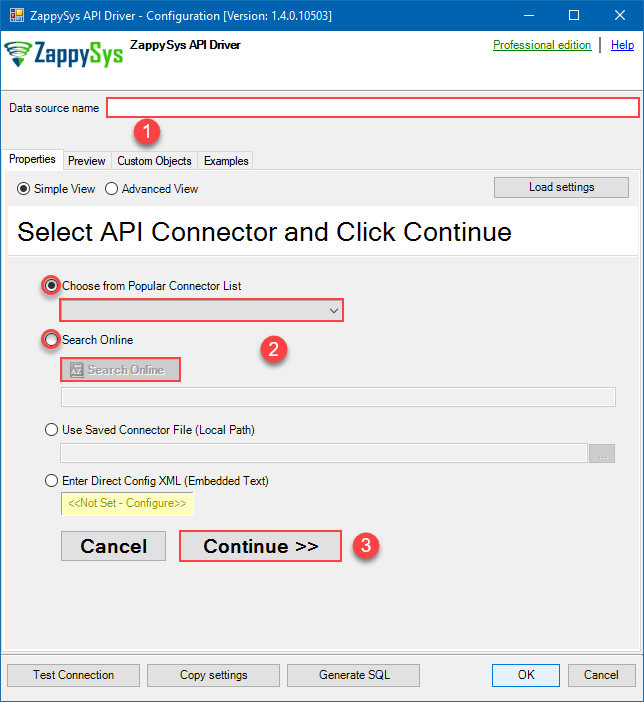
-
Now it's time to configure the Connection Manager. Select Authentication Type, e.g. Token Authentication. Then select API Base URL (in most cases, the default one is the right one). More info is available in the Authentication section.
ElasticSearch authentication
For Local / Hosted Instance by you
- Get your userid / password and enter on the connection UI
For Managed Instance (By Bonsai search)
If your instance is hosted by bonsai then perform these steps to get your credentials for API call- Go to https://app.bonsai.io/clusters/{your-instance-id}/tokens
- Copy Access Key and Access Secret and enter on the connection UI. Click Test connection.
- If your Cluster has no data you can generate sample data by visiting this URL and click Add Sample Data https://{your-cluster-id}.apps.bonsaisearch.net/app/home#/tutorial_directory
API Connection Manager configuration
Just perform these simple steps to finish authentication configuration:
-
Set Authentication Type to
Basic Authentication (UserId/Password) [Http] - Optional step. Modify API Base URL if needed (in most cases default will work).
- Fill in all the required parameters and set optional parameters if needed.
- Finally, hit OK button:
ElasticsearchDSNElasticSearchBasic Authentication (UserId/Password) [Http]http://localhost:9200Optional Parameters User Name (or Access Key) Password (or Access Secret) Ignore certificate related errors 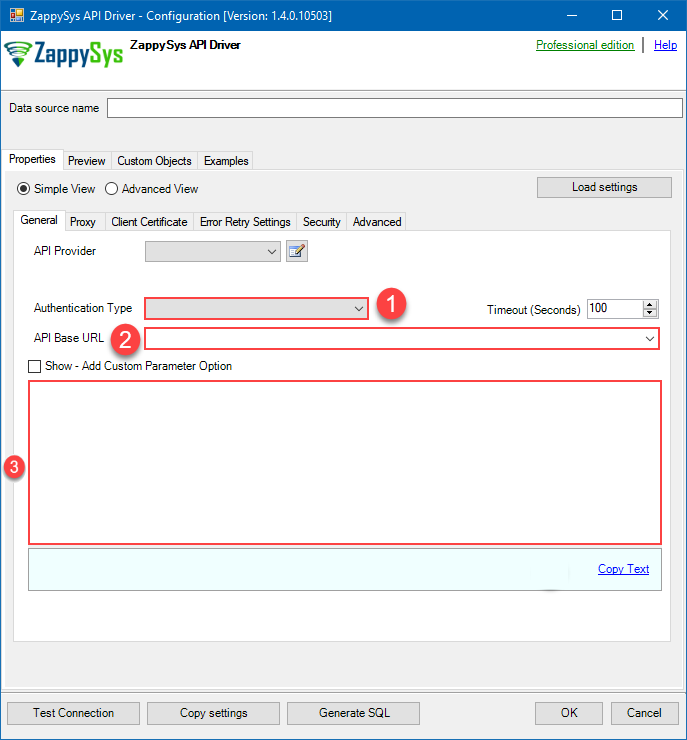
ElasticSearch authentication
No instructions available.
API Connection Manager configuration
Just perform these simple steps to finish authentication configuration:
-
Set Authentication Type to
Windows Authentication (No Password) [Http] - Optional step. Modify API Base URL if needed (in most cases default will work).
- Fill in all the required parameters and set optional parameters if needed.
- Finally, hit OK button:
ElasticsearchDSNElasticSearchWindows Authentication (No Password) [Http]http://localhost:9200Optional Parameters Ignore certificate related errors 
-
Once the data source connection has been configured, it's time to configure the SQL query. Select the Preview tab and then click Query Builder button to configure the SQL query:
ZappySys API Driver - ElasticSearchRead / write ElasticSearch data inside your app; perform many ElasticSearch operations without coding, just use easy to use high performance API Connector for ElasticSearchElasticsearchDSN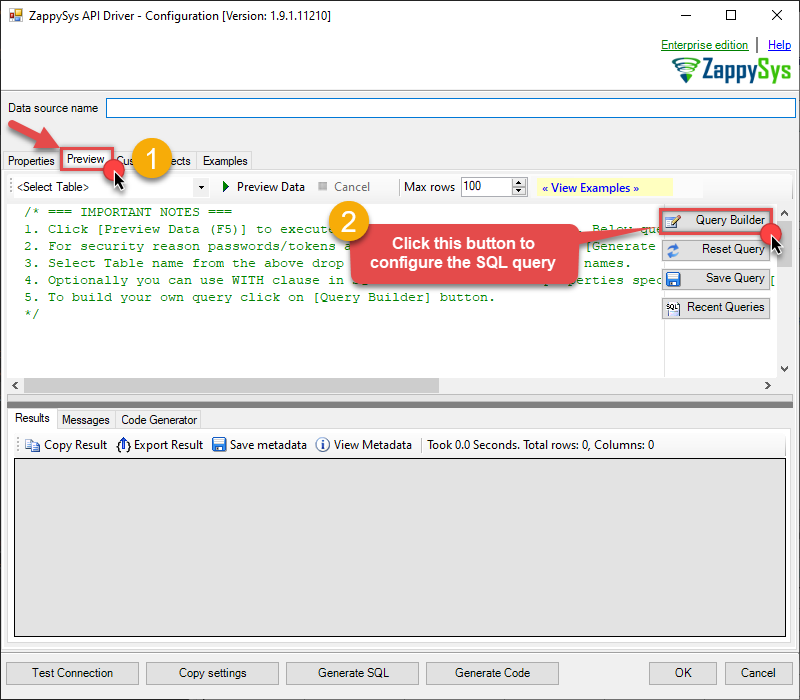
-
Start by selecting the Table or Endpoint you are interested in and then configure the parameters. This will generate a query that we will use in JAVA to retrieve data from ElasticSearch. Hit OK button to use this query in the next step.
SELECT * FROM Indexes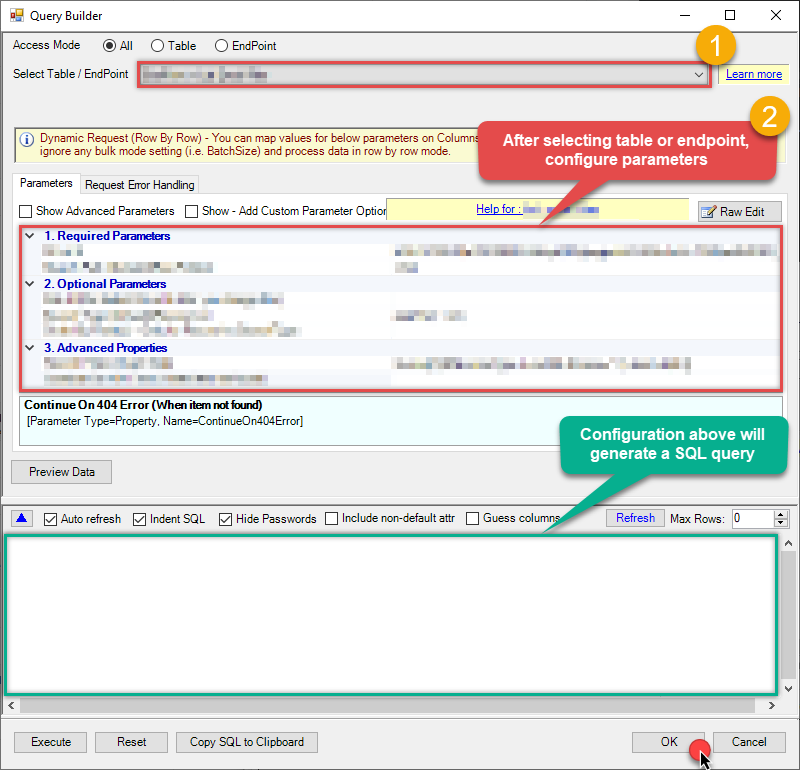 Some parameters configured in this window will be passed to the ElasticSearch API, e.g. filtering parameters. It means that filtering will be done on the server side (instead of the client side), enabling you to get only the meaningful data
Some parameters configured in this window will be passed to the ElasticSearch API, e.g. filtering parameters. It means that filtering will be done on the server side (instead of the client side), enabling you to get only the meaningful datamuch faster . -
Now hit Preview Data button to preview the data using the generated SQL query. If you are satisfied with the result, use this query in JAVA:
ZappySys API Driver - ElasticSearchRead / write ElasticSearch data inside your app; perform many ElasticSearch operations without coding, just use easy to use high performance API Connector for ElasticSearchElasticsearchDSNSELECT * FROM Indexes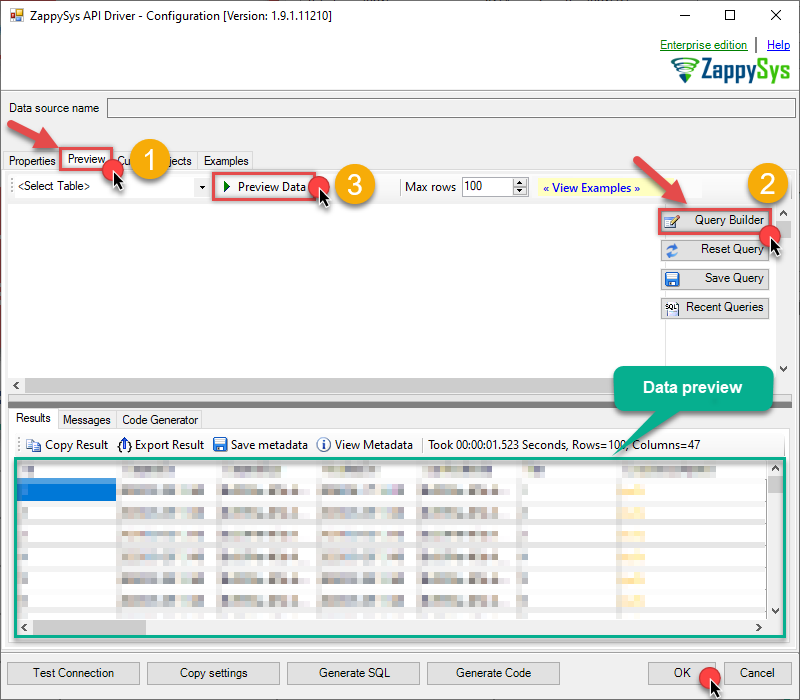 You can also access data quickly from the tables dropdown by selecting <Select table>.A
You can also access data quickly from the tables dropdown by selecting <Select table>.AWHEREclause,LIMITkeyword will be performed on the client side, meaning that thewhole result set will be retrieved from the ElasticSearch API first, and only then the filtering will be applied to the data. If possible, it is recommended to use parameters in Query Builder to filter the data on the server side (in ElasticSearch servers). -
Click OK to finish creating the data source.
-
Very important step. Now, after creating or modifying the data source make sure you:
- Click the Save button to persist your changes.
- Hit Yes, once asked if you want to restart the Data Gateway service.
This will ensure all changes are properly applied:
 Skipping this step may result in the new settings not taking effect and, therefore you will not be able to connect to the data source.
Skipping this step may result in the new settings not taking effect and, therefore you will not be able to connect to the data source.
Read data in Java from the DSN
-
Java code to get the data:
"jdbc:sqlserver://localhost:5000;databasename=ElasticsearchDSN;user=john;password=test"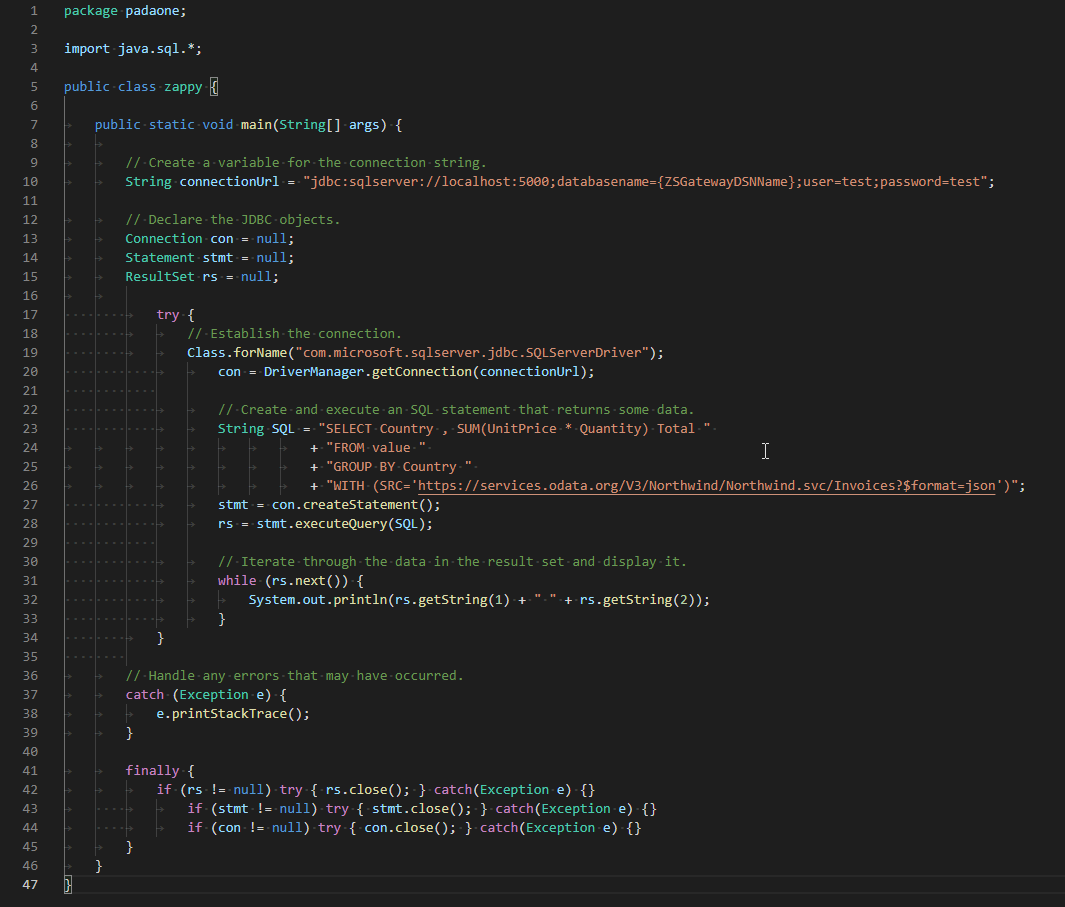
-
When you run the code it will make the API call and read the data:
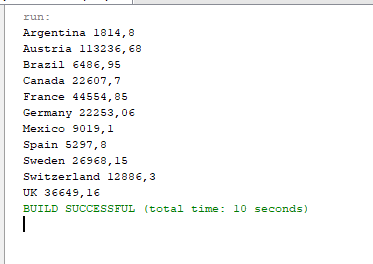
-
Here is Java program's code in text format:
//Step-1: Install ZappySys ODBC PowerPack and Configure Data Gateway //Step-2:Assuming the Microsoft SQL Server JDBC Driver is in below folder //C:\Program Files\Microsoft Jdbc Driver 6.0 for SQL Server\sqljdbc_6.0\enu\auth\x64 package padaone; import java.sql.*; public class zappy { public static void main(String[] args) { // Create a variable for the connection string. String connectionUrl = "jdbc:sqlserver://localhost:5000;databasename=ElasticsearchDSN;user=test;password=test"; // Declare the JDBC objects. Connection con = null; Statement stmt = null; ResultSet rs = null; try { // Establish the connection. Class.forName("com.microsoft.sqlserver.jdbc.SQLServerDriver"); con = DriverManager.getConnection(connectionUrl); // Create and execute an SQL statement that returns some data. String SQL = "SELECT Country , SUM(UnitPrice * Quantity) Total " + "FROM value " + "GROUP BY Country " + "WITH (SRC='https://services.odata.org/V3/Northwind/Northwind.svc/Invoices?$format=json')"; stmt = con.createStatement(); rs = stmt.executeQuery(SQL); // Iterate through the data in the result set and display it. while (rs.next()) { System.out.println(rs.getString(1) + " " + rs.getString(2)); } } // Handle any errors that may have occurred. catch (Exception e) { e.printStackTrace(); } finally { if (rs != null) try { rs.close(); } catch (Exception e) {} if (stmt != null) try { stmt.close(); } catch (Exception e) {} if (con != null) try { con.close(); } catch (Exception e) {} } } }
Actions supported by ElasticSearch Connector
Learn how to perform common ElasticSearch actions directly in JAVA with these how-to guides:
- Count documents
- Create Index
- Delete documents
- Delete Index
- Get document by ID from Index or Alias
- Get documents from Index or Alias
- Get Index or Alias metadata
- Insert documents
- List aliases
- List indexes
- Search / Query documents
- Update documents
- Upsert documents
- Make Generic API Request
- Make Generic API Request (Bulk Write)
Conclusion
In this article we showed you how to connect to ElasticSearch in JAVA and integrate data without any coding, saving you time and effort.
We encourage you to download ElasticSearch Connector for JAVA and see how easy it is to use it for yourself or your team.
If you have any questions, feel free to contact ZappySys support team. You can also open a live chat immediately by clicking on the chat icon below.
Download ElasticSearch Connector for JAVA Documentation


































































